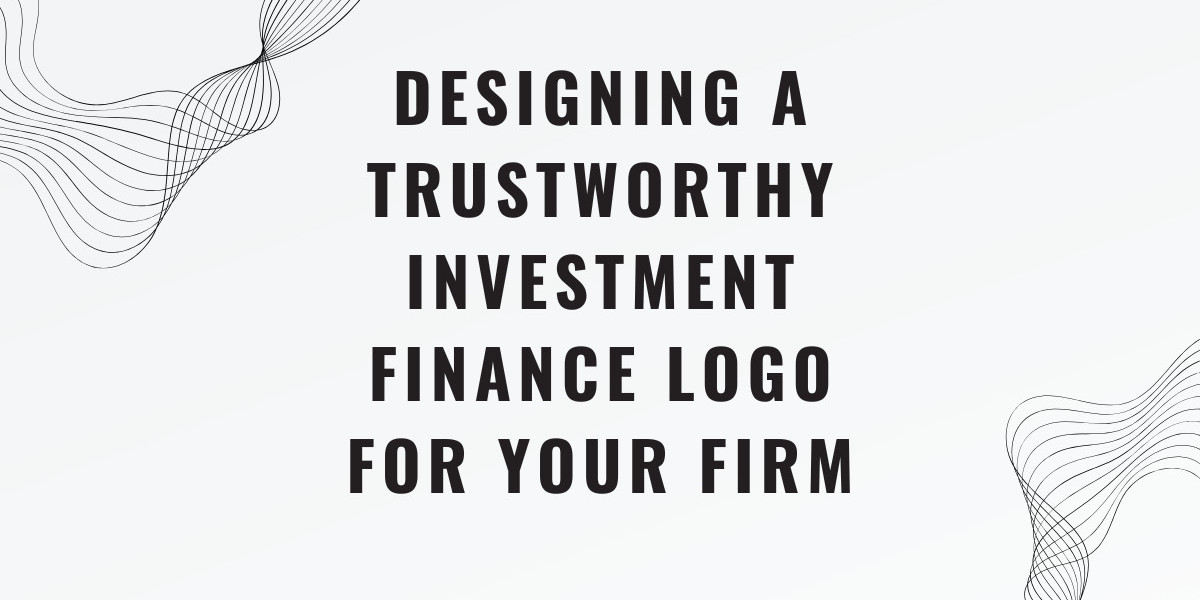Introduction
The right investment finance logo can drive business growth. In the world of finance and investment, trust is paramount. Clients seek financial partners who not only understand the complexities of the market but also prioritize their interests. One of the most effective ways to communicate this trustworthiness is through a well-designed logo. Your investment finance logo serves as the face of your firm, and it plays a crucial role in shaping perceptions and building credibility. Here’s how to design a logo that instills confidence and reflects the core values of your investment finance firm.
1. Understanding the Importance of Your Logo
A logo is more than just a graphic; it’s an essential part of your brand identity. It represents your firm’s values, mission, and commitment to clients. In the investment finance industry, a logo should communicate professionalism, reliability, and a deep understanding of the market. A strong logo can help differentiate your firm from competitors, foster client loyalty, and establish a lasting impression.
2. Defining Your Brand Identity
Before you begin the design process, it’s vital to define your brand identity. Ask yourself the following questions:
- What are your core values?
Understanding what your firm stands for will help guide your logo design.
- Who is your target audience?
Different client segments may resonate with different design elements. Consider whether your audience consists of individual investors, corporations, or institutions.
- What is your unique selling proposition?
Identify what sets your firm apart from others in the investment finance sector. This can inform the imagery and messaging in your logo.
3. Choosing the Right Color Palette
Colors evoke emotions and associations that can significantly influence perceptions of your brand. In the investment finance industry, certain colors are commonly used to convey trust, stability, and professionalism:
- Blue
Often associated with trust and reliability, blue is a popular choice for finance logos. It evokes feelings of security and confidence.
- Green
Symbolizing growth and prosperity, green can reflect financial success and sustainable practices.
- Gray
Conveys sophistication and professionalism, making it a great option for more conservative brands.
Select a color palette that aligns with your brand identity and resonates with your target audience.
4. Selecting Appropriate Typography
The font you choose for your logo is just as important as the imagery. Typography can communicate your brand’s personality and values:
- Serif Fonts
These fonts often convey tradition and reliability. They can give your logo a classic, established feel, which is appealing in the investment finance industry.
- Sans-Serif Fonts
Modern and clean, sans-serif fonts can create a fresh and contemporary look. They are often perceived as more approachable, which can be beneficial for firms targeting individual investors.
- Custom Typography
Consider designing a custom typeface that reflects your brand’s uniqueness and professionalism.
Ensure that your chosen typography is legible and works well in various contexts, from business cards to websites.
5. Incorporating Relevant Imagery
Imagery can enhance the message your logo conveys. In investment finance, consider symbols that resonate with your audience:
- Graphs and Arrows
These elements can symbolize growth, upward trends, and success. They visually represent the goals of your clients.
- Buildings or Columns
These can evoke feelings of stability and strength, reinforcing the idea of a solid financial foundation.
- Abstract Symbols
Sometimes, abstract designs can communicate sophistication and modernity without being overly literal.
Ensure that any imagery used aligns with your brand values and complements the overall design of your logo.
6. Emphasizing Simplicity and Clarity
A successful logo is often simple and clear. Avoid cluttering your design with too many elements or intricate details. A straightforward logo is not only easier to recognize but also more versatile, working well across various mediums, including print, digital, and signage.
Focus on creating a logo that is visually balanced and harmonious. It should be memorable and easily identifiable, allowing clients to recall your brand quickly.
7. Testing and Gathering Feedback
Once you have a few logo concepts, it’s essential to gather feedback from colleagues, clients, and industry professionals. Consider using surveys or focus groups to understand how your logo is perceived. Ask questions such as:
- What emotions does the logo evoke?
- Does it accurately represent our brand values?
- Is it memorable and recognizable?
Use this feedback to refine your design and ensure it resonates with your target audience.
8. Ensuring Versatility
Your logo should be versatile enough to work across various applications. Test how it appears in different formats, including:
- Business Cards
Ensure legibility and impact at a small size.
- Websites and Social Media
Check how it looks on your website and social media profiles.
- Print Materials
Visualize how it will appear on brochures, reports, and other marketing materials.
A versatile logo remains effective regardless of where it is displayed.
9. Working with a Professional Designer
If possible, collaborate with a professional graphic designer who specializes in logo design. They can help bring your vision to life and ensure that your logo is polished and professional. A designer’s expertise can also provide insights into current design trends and best practices in the finance sector.
10. Final Thoughts
Designing a trustworthy investment finance logo is an essential step in building your firm’s brand identity. By understanding your brand values, choosing the right colors and typography, and focusing on simplicity and clarity, you can create a logo that resonates with your audience and communicates professionalism and reliability.
Investing time and effort into your logo design will pay dividends in the long run, helping to establish your firm as a trusted partner in the financial world. A well-designed logo will not only make a lasting impression but also drive your firm’s success for years to come.
FAQs
Q. Why is a logo important for an investment finance firm?
A. A logo is crucial as it represents your firm’s identity and values. It helps establish trust and credibility with clients, reflecting your professionalism and commitment to their financial success.
Q. What key elements should I consider when designing my investment finance logo?
A. Focus on colors, typography, and imagery that evoke trust and stability. Common elements include financial symbols like graphs, arrows, and abstract shapes that represent growth and success.
Q. How do I choose the right color palette for my finance logo?
A. Colors have specific psychological associations. Blue often conveys trust and security, while green symbolizes growth and financial prosperity. Select a palette that aligns with your brand identity and resonates with your target audience.
Q. What type of typography works best for an investment finance logo?
A. Choose clean, professional fonts that convey reliability. Serif fonts can evoke tradition and trust, while sans-serif fonts offer a modern look. Ensure the typography is legible and complements your logo's overall design.
Q. Should I include symbols or imagery in my logo?
A. Yes, incorporating relevant symbols can enhance your logo’s message. Consider using imagery that represents finance, such as upward arrows, graphs, or abstract designs that convey progress and success, but keep it simple and clear.
Q. How can I ensure my logo stands out from competitors?
A. Research your competitors’ logos to identify common themes. Aim for a unique design that reflects your firm’s specific services and values. Distinct color combinations and custom symbols can help set your logo apart.
Q. Is it necessary to hire a professional designer for my logo?
A. While you can create a logo yourself, hiring a professional designer ensures a polished and effective result. Designers have expertise in branding and can create a logo that resonates with your target audience and conveys your brand's message.
Q. How can I test my logo design before finalizing it?
A. Gather feedback from colleagues, clients, and industry peers. Use surveys or focus groups to assess their impressions and gather suggestions for improvement to ensure your logo resonates with your target audience.
Q. How versatile should my logo be?
A. Your logo should be adaptable for various applications, including business cards, websites, and marketing materials. Ensure it remains recognizable and impactful at different sizes and in both color and black-and-white formats.
Q. What if I need to update my logo in the future?
A. If you decide to update your logo, maintain key elements from the original design to preserve brand recognition. Clearly communicate the reasons for the update to your audience to help them adjust while reinforcing your firm’s identity.








